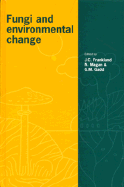Book contents
- Frontmatter
- Contents
- List of contributors
- Preface
- 1 Effects of climate change on fungal diseases of trees
- 2 Effects of climate change on Fusarium foot rot of winter wheat in the United Kingdom
- 3 Effects of UV-B radiation (280–320 nm) on foliar saprotrophs and pathogens
- 4 Implications of global warming and rising sea-levels for macrofungi in UK dune systems
- 5 Red Data Lists and decline in fruiting of macromycetes in relation to pollution and loss of habitat
- 6 Effects of dry-deposited SO2 and sulphite on saprotrophic fungi and decomposition of tree leaf litter
- 7 Effects of atmospheric pollutants on phyllosphere and endophytic fungi
- 8 Influences of acid mist and ozone on the fluorescein diacetate activity of leaf litter
- 9 Mycorrhizas and environmental stress
- 10 Myccorhizas, succession, and the rehabilitation of deforested lands in the humid tropics
- 11 Potential effects on the soil mycoflora of changes in the UK agricultural policy for upland grasslands
- 12 Uptake and immobilization of caesium in UK grassland and forest soils by fungi, following the Chernobyl accident
- 13 Effects of pollutants on aquatic hyphomycetes colonizing leaf material in freshwaters
- 14 Fungi and salt stress
- 15 Fungal sequestration, mobilization and transformation of metals and metalloids
- 16 Urban, industrial and agricultural effects on lichens
- 17 Fungal interactions with metals and radionuclides for environmental bioremediation
- 18 Impact of genetically-modified microorganisms on the terrestrial microbiota including fungi
- 19 Has chaos theory a place in environmental mycology?
- Index of generic and specific names
- Subject index
1 - Effects of climate change on fungal diseases of trees
Published online by Cambridge University Press: 05 November 2011
- Frontmatter
- Contents
- List of contributors
- Preface
- 1 Effects of climate change on fungal diseases of trees
- 2 Effects of climate change on Fusarium foot rot of winter wheat in the United Kingdom
- 3 Effects of UV-B radiation (280–320 nm) on foliar saprotrophs and pathogens
- 4 Implications of global warming and rising sea-levels for macrofungi in UK dune systems
- 5 Red Data Lists and decline in fruiting of macromycetes in relation to pollution and loss of habitat
- 6 Effects of dry-deposited SO2 and sulphite on saprotrophic fungi and decomposition of tree leaf litter
- 7 Effects of atmospheric pollutants on phyllosphere and endophytic fungi
- 8 Influences of acid mist and ozone on the fluorescein diacetate activity of leaf litter
- 9 Mycorrhizas and environmental stress
- 10 Myccorhizas, succession, and the rehabilitation of deforested lands in the humid tropics
- 11 Potential effects on the soil mycoflora of changes in the UK agricultural policy for upland grasslands
- 12 Uptake and immobilization of caesium in UK grassland and forest soils by fungi, following the Chernobyl accident
- 13 Effects of pollutants on aquatic hyphomycetes colonizing leaf material in freshwaters
- 14 Fungi and salt stress
- 15 Fungal sequestration, mobilization and transformation of metals and metalloids
- 16 Urban, industrial and agricultural effects on lichens
- 17 Fungal interactions with metals and radionuclides for environmental bioremediation
- 18 Impact of genetically-modified microorganisms on the terrestrial microbiota including fungi
- 19 Has chaos theory a place in environmental mycology?
- Index of generic and specific names
- Subject index
Summary
Introduction
Climate has been of great importance in the development of associations between trees and pathogenic fungi. In particular, the geographic range of each species of tree or fungus is delimited by factors such as temperature, moisture, snowfall and windiness which affect growth, reproduction and dispersal. Such factors affect the incidence of diseases by determining the distribution of a particular pathogen in relation to the geographic range of a potential host. Also, within a region where both host and pathogen are present, the severity of disease can vary with climate. Such variations can result from the direct effects of climatic factors on the pathogen, or from their effects on aspects of host physiology which determine resistance to attack. Other effects may involve other organisms with which either the host or pathogen interact.
In natural ecosystems, associations between particular tree and fungal species are often of great antiquity and have evolved in ways which tend to avoid mutual destruction. Environmental stability may have been a prerequisite for the development of many of these host-pathogen associations and, if that is the case, it follows that they will be perturbed by major climate change. Less stable relationships tend to occur in the simpler ecosystems that initially exist in man-made plantations, often involving new combinations of host and pathogen species that have artificially been transported beyond their natural geographic ranges.
- Type
- Chapter
- Information
- Fungi and Environmental Change , pp. 1 - 19Publisher: Cambridge University PressPrint publication year: 1996
- 20
- Cited by

